Crocs In Paradise! (aka The Maldives)
Story by Jake Howard | Photos by Tom Carey For anybody that’s had the privilege of surfing in the Maldives, you know. You know it’s paradise. It’s nirvana times a thousand. The water’s as clear as a bottle of gin. The waves are warm and inviting. And for the most part the sea life, while spectacular, will not eat you. But in the first couple of months of 2015 that seems to be changing. In January and February there were 13 reported saltwater crocodile sightings in the Maldives. That wouldn’t be weird, but saltwater crocs aren’t native to the Maldives. The first croc was spotted back in 2008, and nobody really knows how it got there. Since then the nation with the world’s lowest elevation experienced an average of one sighting per year. Don’t, like, not go to the Maldives. Just… y’know… something to think about. Mitch Coleborn, paradise slice. “We had a crocodile sighting in 2008, but that croc’s now in lock-up at the children’s park,” says Ahmed Aznil, the president of the Maldives Surfing Association. “Since then there’s been no more than one croc sighting a year. Some years have no activity, but in 2015 we’ve had more than 13 sightings in less than two months.” “The Maldives National Defense Force (MNDF) is responding,” continues Ahmed. “They’ve tried to capture these crocs, but we don’t have trained people for this or the necessary tools. Only three have been captured so far. The local media sends out updates of croc sightings with locations and a map to help make people aware.” Yago Dora and a very desirable position, should any unwanted locals drift into the lineup. It appears as if it’s a seasonal thing, with 90 percent of the croc sightings over the last five years being reported during the Northwest monsoon season, which runs from November through April. Thankfully the prime surfing months in the Maldives are June, July and August. “They’re mostly being seen around the reefs, but occasionally out in the open water by fishermen trawling for bait,” says Aznil. “It’s mostly swimmers, divers and fishermen that are making the reports.” Because saltwater crocs are crafty creatures, they will usually watch their prey for days or weeks, studying its regular activity before striking. Good news for a traveling surfer who’s just swinging through one spot for a session or two. And most attacks occur in shallow water — so wearing a leash might be a good idea. How easily might a croc jaw crunch through two-and-a-half inches of foam and fibreglass? Hopefully, Nate Tyler will never find out. This is he, Maldives livin’. But yes, they have huge teeth and an appetite, so they are a threat. “They can kill you,” surmises Ahmed. “Not just surfers, but anybody out for a swim, fishermen, people snorkelling and diving.” The news out of the Maldives coincides with a noticeable rise in encounters with apex predators globally. The US west coast has seen three times as many shark attacks since the turn of the century according to the independent Shark Research Committee, and in 2014 there were six attacks on people in California, three of the victims were surfers (none of them fatal). Meanwhile, Australia is still reeling from the fatal attack of a Japanese surfer in normally tranquil Ballina, and a spear fisherman was killed in December at Cheynes Beach in West Oz. Great whites are everywhere, orcas are sweeping through the Uluwatu lineup, and now there’s salty crocs hanging out on Maldivian reefs… what’s up, 2015? More and more it’s sounding like an amazing time to take up bowling. This place really is a blue paradise. Hopefully salty crocs aren’t the thing that makes it less so. Mitch Coleborn sweeps the highlighter pen.
Story by Jake Howard | Photos by Tom Carey
For anybody that’s had the privilege of surfing in the Maldives, you know. You know it’s paradise. It’s nirvana times a thousand. The water’s as clear as a bottle of gin. The waves are warm and inviting. And for the most part the sea life, while spectacular, will not eat you. But in the first couple of months of 2015 that seems to be changing.
In January and February there were 13 reported saltwater crocodile sightings in the Maldives. That wouldn’t be weird, but saltwater crocs aren’t native to the Maldives. The first croc was spotted back in 2008, and nobody really knows how it got there. Since then the nation with the world’s lowest elevation experienced an average of one sighting per year.
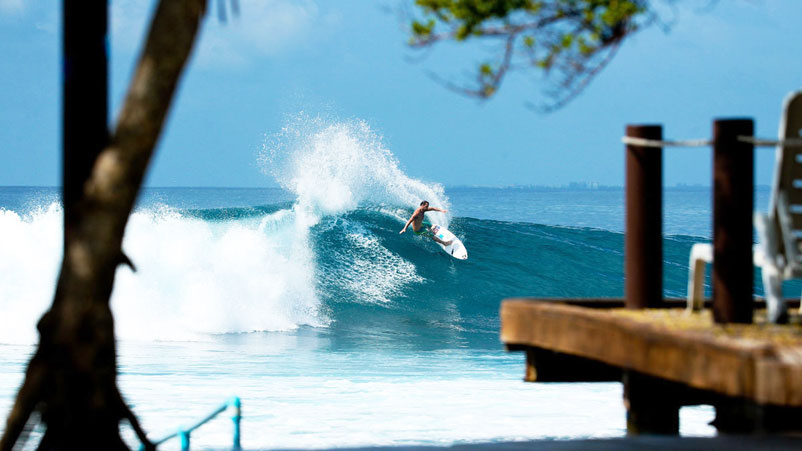
Don’t, like, not go to the Maldives. Just… y’know… something to think about. Mitch Coleborn, paradise slice.
“We had a crocodile sighting in 2008, but that croc’s now in lock-up at the children’s park,” says Ahmed Aznil, the president of the Maldives Surfing Association. “Since then there’s been no more than one croc sighting a year. Some years have no activity, but in 2015 we’ve had more than 13 sightings in less than two months.”
“The Maldives National Defense Force (MNDF) is responding,” continues Ahmed. “They’ve tried to capture these crocs, but we don’t have trained people for this or the necessary tools. Only three have been captured so far. The local media sends out updates of croc sightings with locations and a map to help make people aware.”
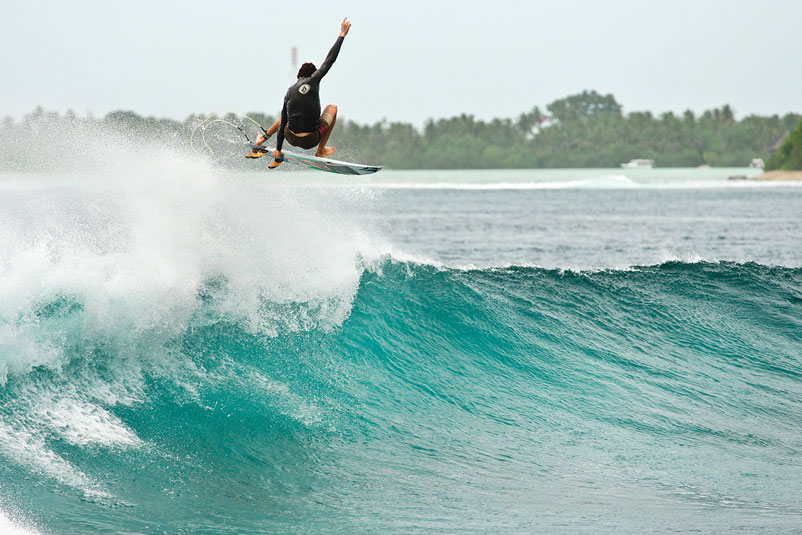
Yago Dora and a very desirable position, should any unwanted locals drift into the lineup.
It appears as if it’s a seasonal thing, with 90 percent of the croc sightings over the last five years being reported during the Northwest monsoon season, which runs from November through April. Thankfully the prime surfing months in the Maldives are June, July and August.
“They’re mostly being seen around the reefs, but occasionally out in the open water by fishermen trawling for bait,” says Aznil. “It’s mostly swimmers, divers and fishermen that are making the reports.”
Because saltwater crocs are crafty creatures, they will usually watch their prey for days or weeks, studying its regular activity before striking. Good news for a traveling surfer who’s just swinging through one spot for a session or two. And most attacks occur in shallow water — so wearing a leash might be a good idea.
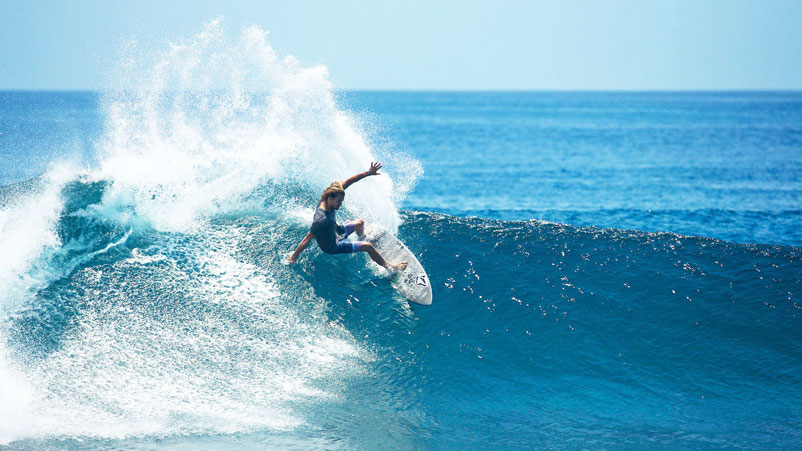
How easily might a croc jaw crunch through two-and-a-half inches of foam and fibreglass? Hopefully, Nate Tyler will never find out. This is he, Maldives livin’.
But yes, they have huge teeth and an appetite, so they are a threat. “They can kill you,” surmises Ahmed. “Not just surfers, but anybody out for a swim, fishermen, people snorkelling and diving.”
The news out of the Maldives coincides with a noticeable rise in encounters with apex predators globally. The US west coast has seen three times as many shark attacks since the turn of the century according to the independent Shark Research Committee, and in 2014 there were six attacks on people in California, three of the victims were surfers (none of them fatal). Meanwhile, Australia is still reeling from the fatal attack of a Japanese surfer in normally tranquil Ballina, and a spear fisherman was killed in December at Cheynes Beach in West Oz. Great whites are everywhere, orcas are sweeping through the Uluwatu lineup, and now there’s salty crocs hanging out on Maldivian reefs… what’s up, 2015? More and more it’s sounding like an amazing time to take up bowling.
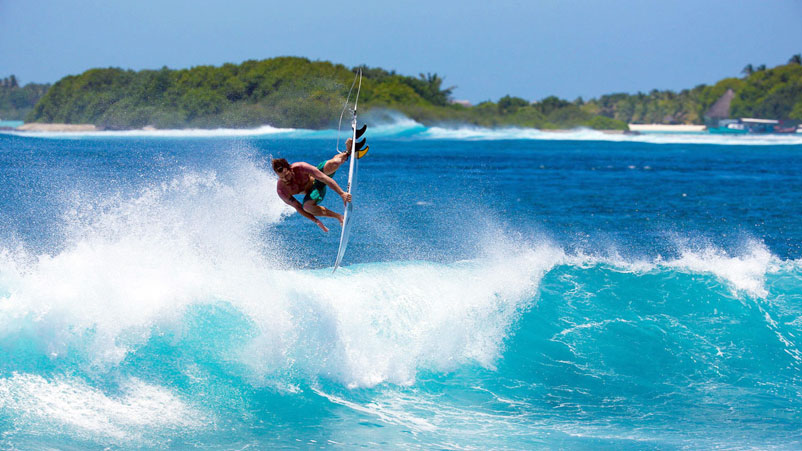
This place really is a blue paradise. Hopefully salty crocs aren’t the thing that makes it less so. Mitch Coleborn sweeps the highlighter pen.




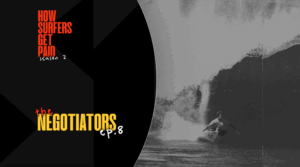
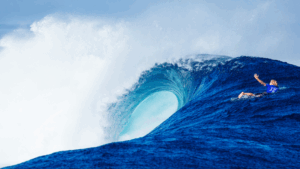
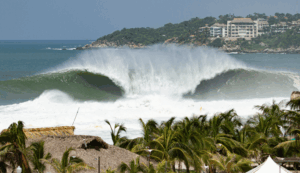







Comments
Comments are a Stab Premium feature. Gotta join to talk shop.
Already a member? Sign In
Want to join? Sign Up